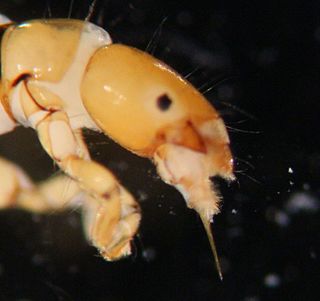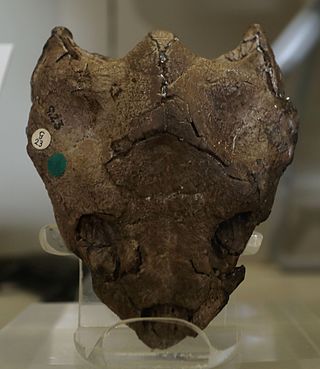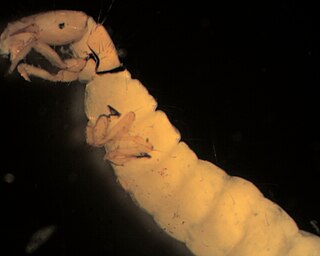
Sunnyodon is a genus of tiny, extinct mammal, probably of the Lower Cretaceous. Found in what is now southern England and Denmark, it was a relatively early member of the extinct order of Multituberculata. It is part of the suborder Plagiaulacida and family Paulchoffatiidae.
Gerhardodon is an extinct genus of mammal from the Lower Cretaceous of southern England. It was a member of the also extinct order of Multituberculata, and lived with such dinosaurs as Iguanodon. It lies within the suborder "Plagiaulacida" and family Pinheirodontidae.
Loxaulax is a genus of extinct mammal from the Lower Cretaceous of southern England. It was a member of the also extinct order Multituberculata, and lived alongside the dinosaurs. It lies within the suborder "Plagiaulacida" and family Eobaataridae. The genus Loxaulax was named by Simpson G.G. in 1928 based on one species.

Valdosaurus is a genus of bipedal herbivorous iguanodont ornithopod dinosaur found on the Isle of Wight and elsewhere in England, Spain and possibly also Romania. It lived during the Early Cretaceous.

Eotyrannus is a genus of tyrannosauroid theropod dinosaur hailing from the Early Cretaceous Wessex Formation beds, included in Wealden Group, located in the southwest coast of the Isle of Wight, United Kingdom. The remains (MIWG1997.550), consisting of assorted skull, axial skeleton and appendicular skeleton elements, from a juvenile or subadult, found in a plant debris clay bed, were described by Hutt et al. in early 2001. The etymology of the generic name refers to the animal's classification as an early tyrannosaur or "tyrant lizard", while the specific name honors the discoverer of the fossil.

Lonchodectes was a genus of lonchodectid pterosaur from several formations dating to the Turonian of England, mostly in the area around Kent. The species belonging to it had been assigned to Ornithocheirus until David Unwin's work of the 1990s and 2000s. Several potential species are known; most are based on scrappy remains, and have gone through several other generic assignments. The genus is part of the complex taxonomy issues surrounding Early Cretaceous pterosaurs from Brazil and England, such as Amblydectes, Anhanguera, Coloborhynchus, and Ornithocheirus.

Dipseudopsidae is a family of caddisflies in the order Trichoptera. There are about 6 genera and at least 110 described species in Dipseudopsidae.

Pachyrhizodus is an extinct genus of ray-finned fish that lived during the Cretaceous to Paleocene in what is now Europe, North America, South America, and Oceania. Many species are known, primarily from the Cretaceous of England and the midwestern United States.

Athericidae is a small family of flies known as water snipe flies or ibis flies. They used to be placed in the family Rhagionidae, but were removed by Stuckenberg in 1973. They are now known to be more closely related to Tabanidae. Species of Athericidae are found worldwide.

Dorsetochelys is an extinct genus of turtle from the Early Cretaceous of southern England and northwestern Germany.

Oweniasuchus is an extinct genus of goniopholidid mesoeucrocodylian. Remains have been found from England and Portugal that are Cretaceous in age.

Owenodon is a genus of iguanodontian dinosaur known from a partial lower jaw discovered in Early Cretaceous-age rocks of Dorset, United Kingdom, and possibly also Romania and Spain. The first and only definitive specimen was found in the Lulworth Formation of the Purbeck Limestone Group, dating to the middle Berriasian stage. It was first described by Richard Owen as a species Iguanodon, I. hoggii, honouring naturalist A.J. Hogg who had originally collected the fossil. Owen described the mandible as it was, partially embedded in a limestone block, but it was given to the Natural History Museum, London where it was accessioned as NHMUK PV R 2998 and further prepared. Some damage occurred to a tooth crown and part of the bone while stored in the collections. Redescription of I. hoggii by David Norman and Paul Barrett subsequently transferred the species to Camptosaurus in 2002, as well as tentatively referring other camptosaur-like material from the Purbeck beds to the species. The identity of the species was questioned, with Kenneth Carpenter and Yvonne Wilson, and Greg Paul, separating "C." hoggi from Camptosaurus as an intermediate ornithopod, until Peter Galton named the new genus Owenodon for it in 2009. Galton removed the material assigned by Norman and Barrett from Owenodon, but referred isolated teeth from the Bauxite of Cornet, Romania, and the El Castellar Formation of Spain to O. hoggii. The taxon, believed by Galton to be intermediate between Camptosaurus and Iguanodon, is of uncertain relationships, with the limited material preventing clear understanding of its position within ornithopod evolution. Phylogenetic studies have found Owenodon to be more primitive, equivalent to, or more derived than Camptosaurus, but it is often excluded to improve results.
Kurmademys is an extinct genus of side-necked turtle which existed in India during the late Cretaceous period. It was first named in 2001, by Eugene S. Gaffney, Sankar Chatterjee, and Dhiraj K. Rudra, and contains the species Kurmademys kallamedensis. The species name is derived from the Kallamedu Formation of southern India, where the type specimen of the genus was discovered. It was assigned to the family Bothremydidae.

Dysoneuridae is an extinct family of insect in the order Trichoptera, the caddisflies. The family was first described by I.D. Sukacheva in 1968, and lived from the Middle Jurassic to mid-Cretaceous.

Wormaldia is a genus of fingernet caddisflies in the family Philopotamidae. There are more than 140 described species in Wormaldia. Fossil species have been described from the Late Cretaceous Burmese amber of Myanmar.

Phylocentropus is a genus of caddisflies in the family Dipseudopsidae. There are about 17 described species in Phylocentropus.
Prochita is an extinct genus of caddisflies in the family Dysoneuridae. It contains only one species, Prochita rasnitsyni. The genus is known from the Upper Jurassic—Lower Cretaceous of the Transbaikal region of Russia.
Cretapsyche is an extinct genus of caddisflies in the extinct family Dysoneuridae. It is from the Late Cretaceous (Cenomanian) and specimens are from Burmese amber.
Thereuodon is a genus of extinct mammal known from the Early Cretaceous of southern England, Morocco and France. The type species, named by Denise Sigogneau-Russell in 1989 for teeth from the earliest Cretaceous Ksar Metlili Formation of Morocco, is Thereuodon dahmani, while the referred species named by Sigogneau-Russell and Paul Ensom for teeth from the Lulworth Formation of England is Thereuodon taraktes. The two species are separated by a break in the cingulum in T. dahmani, a more obtuse medial crest in T. taraktes, a duller stylocone in T. taraktes, a "c" cuspule in T. dahmani, and a reduced facet A in T. taraktes. The genus Thereuodon is the only taxon in the symmetrodont family Thereuodontidae, which may be closely related to Spalacotheriidae. A tooth referred to T. cf. taraktes is known from the Berriasian aged Angeac-Charente bonebed of France.

Draigwenia is an extinct genus of pterosaur known from a jaw fragment found in the Late Cretaceous Cambridge Greensand in the United Kingdom. The fossil was likely reworked from an Early Cretaceous layer that can be dated to the Albian. It currently contains a single species, Draigwenia platystomus.












